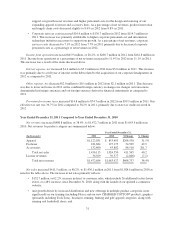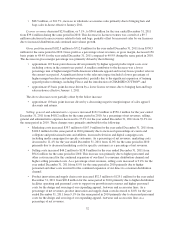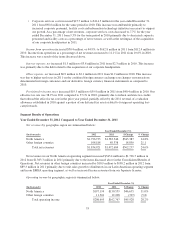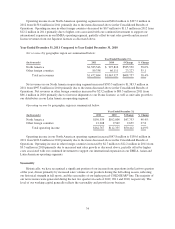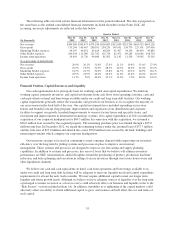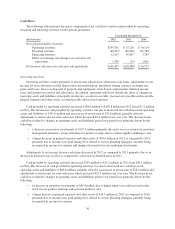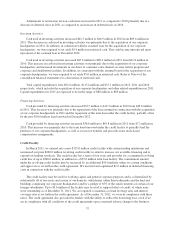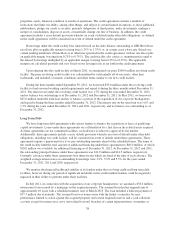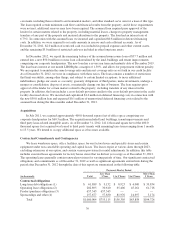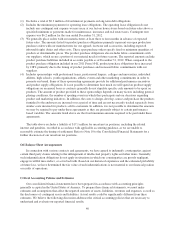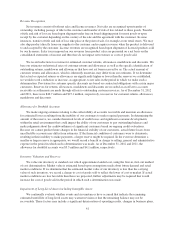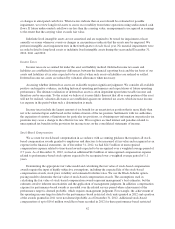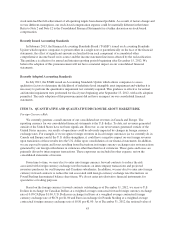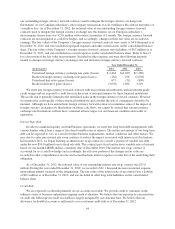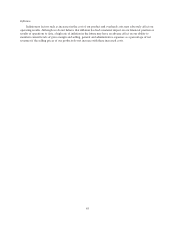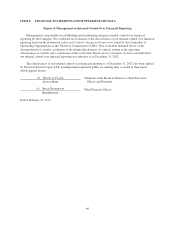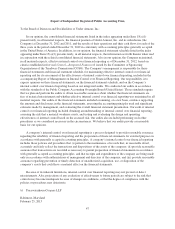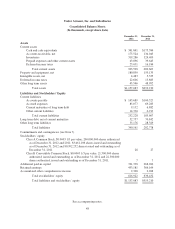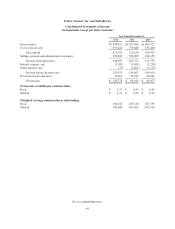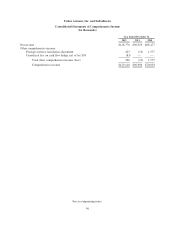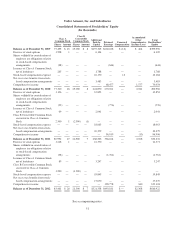Under Armour 2012 Annual Report Download - page 49
Download and view the complete annual report
Please find page 49 of the 2012 Under Armour annual report below. You can navigate through the pages in the report by either clicking on the pages listed below, or by using the keyword search tool below to find specific information within the annual report.Revenue Recognition
Net revenues consist of both net sales and license revenues. Net sales are recognized upon transfer of
ownership, including passage of title to the customer and transfer of risk of loss related to those goods. Transfer
of title and risk of loss are based upon shipment under free on board shipping point for most goods or upon
receipt by the customer depending on the country of the sale and the agreement with the customer. In some
instances, transfer of title and risk of loss take place at the point of sale, for example at our retail stores. We may
also ship product directly from our supplier to the customer and recognize revenue when the product is delivered
to and accepted by the customer. License revenues are recognized based upon shipment of licensed products sold
by our licensees. Sales taxes imposed on our revenues from product sales are presented on a net basis on the
consolidated statements of income and therefore do not impact net revenues or costs of goods sold.
We record reductions to revenue for estimated customer returns, allowances, markdowns and discounts. We
base our estimates on historical rates of customer returns and allowances as well as the specific identification of
outstanding returns, markdowns and allowances that have not yet been received by us. The actual amount of
customer returns and allowances, which is inherently uncertain, may differ from our estimates. If we determine
that actual or expected returns or allowances are significantly higher or lower than the reserves we established,
we would record a reduction or increase, as appropriate, to net sales in the period in which we make such a
determination. Provisions for customer specific discounts are based on contractual obligations with certain major
customers. Reserves for returns, allowances, markdowns and discounts are recorded as an offset to accounts
receivable as settlements are made through offsets to outstanding customer invoices. As of December 31, 2012
and 2011, there were $40.7 million and $27.1 million, respectively, in reserves for customer returns, allowances,
markdowns and discounts.
Allowance for Doubtful Accounts
We make ongoing estimates relating to the collectability of accounts receivable and maintain an allowance
for estimated losses resulting from the inability of our customers to make required payments. In determining the
amount of the reserve, we consider historical levels of credit losses and significant economic developments
within the retail environment that could impact the ability of our customers to pay outstanding balances and
make judgments about the creditworthiness of significant customers based on ongoing credit evaluations.
Because we cannot predict future changes in the financial stability of our customers, actual future losses from
uncollectible accounts may differ from estimates. If the financial condition of customers were to deteriorate,
resulting in their inability to make payments, a larger reserve might be required. In the event we determine a
smaller or larger reserve is appropriate, we would record a benefit or charge to selling, general and administrative
expense in the period in which such a determination was made. As of December 31, 2012 and 2011, the
allowance for doubtful accounts was $3.3 million and $4.1 million, respectively.
Inventory Valuation and Reserves
We value our inventory at standard cost which approximates landed cost, using the first-in, first-out method
of cost determination. Market value is estimated based upon assumptions made about future demand and retail
market conditions. If we determine that the estimated market value of our inventory is less than the carrying
value of such inventory, we record a charge to cost of goods sold to reflect the lower of cost or market. If actual
market conditions are less favorable than those we projected, further adjustments may be required that would
increase the cost of goods sold in the period in which such a determination was made.
Impairment of Long-Lived Assets including Intangible Assets
We continually evaluate whether events and circumstances have occurred that indicate the remaining
estimated useful life of long-lived assets may warrant revision or that the remaining balance may not be
recoverable. These factors may include a significant deterioration of operating results, changes in business plans,
41


